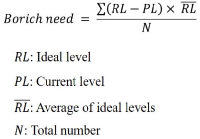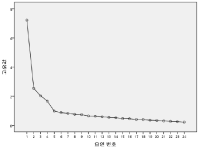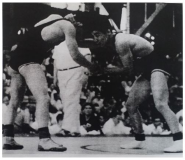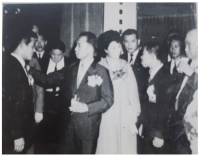PURPOSE This study analyzed the relationship among coaching behaviors, motivational climate, sports competence, effort, and failure tolerance as perceived by high school athletes. Additionally, it examined whether motivational climate, competence, and effort mediate the relationship between coaching behaviors and failure tolerance. METHODS Using questionnaires measuring autonomy-supportive coaching behavior, controlling coaching behavior, motivational climate, sports competence, effort, and failure tolerance, 365 high school athletes were surveyed. Using SPSS 28.0 and Amos 28.0 software, descriptive statistics and structural equation modeling were conducted along with the following types of analyses: reliability, correlation, confirmatory factor, convergent validity, and discriminant. Additionally, the bootstrap method was used to verify serial multiple mediating effects. RESULTS Autonomy-supportive behavior had a significant positive effect 1) on motivational climate, sports competence, and effort and 2) on failure tolerance. 3) Controlling coaching behavior had a significant negative effect on motivational climate and sports competence. 4) Motivational climate and 5) sports competence both had a significant positive effect on effort. 6) Effort had a significant positive effect on failure tolerance. Last, in the relationship between autonomy-supportive behavior and failure tolerance, motivational climate, sports competence, and effort showed partial mediating effects. CONCLUSIONS This study confirms the importance of coaches’ autonomy-supportive behavior in determining failure tolerance among adolescent athletes. Based on this information, counseling (educational) programs aimed at enhancing performance can be developed and provided in sports settings, thus fostering success among athletes.

Purpose This study was designed to develop a curriculum for pre-service golf coaches at universities to enhance the coaches’ competencies to counsel athletes on the field. Methods This study was conducted in accordance with the revised and supplemented procedures for the national competency standard (NCS) based curriculum development outline under the level of application of individual instruction-level classes among the types of curriculum development. Results The results were as follows: First, the elements of the counseling competence were guided by conflict resolution counseling, psychological skills training, guidance counseling, coordination and Intervention, and relationship formation. Second, the curriculum was adopted as a curriculum for sports psychology, theory and practice of counseling, counseling practice and super-vision, and psychological skills training, and non-disciplinary activities were participation in group and personal counseling, and an open counseling case study. Third, the feasibility of the curriculum was calculated in the range of 0.8 to 1.0 for all areas to be reasonable. Conclusions The results of this study have structured the counseling competencies required for pre-service golf coaches. Based on this, the results of the study suggest counseling courses in the curriculum of university. This is expected to ultimately seek to improve the coaching field by enhancing the capacity of the coaches.



The purpose of this study was to examine the current status of school sport club(SSC) participation and to explore relationship between school sport participation and positive youth development. In order to do this, a survey was conducted with 403 elementary, middle, and high school teachers who are currently taking charge of SSCs, and also individual interviews were conducted with 22 students. In addition, the youths' developmental asset questionnaire was administered with 412 middle school students. The survey results from 403 teachers showed that SSCs have potential to contribute to positive youth development because teachers are placing an emphasis on character development as well as physical and social development through SSC activities. In addition, participants who regularly participate in physical activities had higher internal and external developmental assets than non-participants or irregular participants. Specifically, students participated in SSC more than twice a week had higher internal and external assets than students participate once a week. In addition, participants who engage more than one hour per session had higher internal and external assets except constructive use of time and social competence. Discussion and implications for organizing SSCs to provide developmental contexts and contents for positive youth development were provided.

Purpose: This study was to verify the relationship between coaching behavior(autonomy/controlling behavior), self-regulation motivation and performance. Method: 356 athletes (from middle to work and professional team) in individual and team sport completed coaching behavior scale developed by this researchers assessing autonomy and controlling coaching behavior perceived by players, Korea Basic Pyshoclogical Needs Scale (KBPNS) assessing basic psychological needs, Behavioral Regulation in Sport Questionnaire (BRSQ) assessing sports motivation level based on self-determination theory, and sport performance score. To estimate the relationship between coaching behavior, self-regulation motivation and performance, this study employed the structure equation modeling analysis. Results: The relationship between psychological needs, regulation motivation and performance showed that autonomy coaching behavior tend to reinforce competence and autonomy of player. These variables have a positive effect on more inner regulation motivation. Moreover, the intrinsic motivation through stimulation experience was a key factor leading to a positive performance by improving the performance strategy and skill of athletes. Conclusion: These results are meaningful as an empirical evidence that relationship between motivation and performance can be changed according to the type of coaching behavior, and that autonomous coaching behavior play an important role in maximizing the performance of player that provided theoretically form.


Purpose The purpose of this study was to develop the sport 5C scale of the Korean version. Methods The participants were 772 high school students from 17 to 19 who participated in sport regularly. The validation of Sport K-5C followed a three-step validation procedure through substantive stage, structural stage, and external stage. Results First, In the substantive stage, Sport K-5C consisted of 50 items with 5 factors. Second, in the structural stage, although Sport K-5C was explored as 24 items with 4 factors by EFA, but as a result of CFA, Sport K-5C was confirmed as 24 items with 5 factors. Third, the external stage provided additional validity through correlations of tests with other questionnaires which are similar concept and opposite concept, and group differentiation. Conclusions Sport K-5C is composed of 5 factors and 24 items. The factors are Caring, Character, Confidence, Competence, Connection. This scale can be used to provide an objective evaluation of positive development of youth in sport and physical education context.

Purpose The purpose of this study was to analyzes the task related to job creation of sport industry sector in the 3rd(2019~2023) sport industry long-term plan and suggest possible revisions of the sport industry relevant laws. Methods This study focused on literature review on sport industry long-term plan, sport related legal and regulations reviews. To achieve the purpose of the study effectively, the legislative purpose and main contents of the Sports Industry Promotion Law were examined, and the legislation and amendment policy measures dealing with new job creation and reinforcement of sport industry manpower, according to sports industry long-term plan. Results First, To promote job creation in sport industry, the provision of sport relevant laws including fostering sport industry specialized manpower, settling down the system to meet the demands of industrial sites and establishing specialized higher education institutions that can strengthen their capabilities. Second, as the paradigm of creating jobs value added in sport industry has changed into a state-of-the-art convergence-and-composite based system such as the Fourth Industrial Revolution, legal systems that can reflect and implement it is urgently needed. Therefore, institutionally preemptive measures should be established before being new technological wave settled down in advance. Third, the development of a curriculum with substantial resources for strengthening the practical competency of sport industry manpower should be continued, and a revision of sport related laws on securing the budget is required. Conclusions By revising the current sport industry associated laws, it is expected to build a cornerstone on promoting job creation in sport industry.
PURPOSE This study first investigated how different types of sport team logos (emblem vs. mascot) influence consumer behavior through warmth and competence and then examined the moderating effects of consumer characteristics (gender) and contextual cues (perceived competence) on these relationships. METHODS A nationwide sample of adults age 20 was selected using quota random sampling based on gender. A 2 (logo type: emblem vs. mascot) × 2 (gender) × 2 (contextual cue: high competence vs. low competence) experimental design was employed, with participants randomly assigned to each group. Confirmatory factor analysis (CFA) with Mplus 8 was employed to assess the measurement model’s reliability and validity, and hypothesis testing was conducted through structural equation modeling (SEM), measurement invariance tests, and multigroup SEM analysis. RESULTS Findings indicate that anthropomorphized mascot logos, compared to emblem logos, generate more positive attitudes and psychological responses (warmth and competence) to the team. Gender’s moderating effect on the relationship between logo type and consumer perceptions (warmth and competence) was not significant, but contextual cues’ moderating effect was partially significant. CONCLUSIONS This study highlights of perceived warmth and competence’s crucial role in shaping consumer attitudes toward sports teams through logo design. These findings offer meaningful insights for sports teams and marketers to optimize branding strategies and enhance fan engagement.

Purpose The purpose of this study was to examine students’ perceptions of girls’ participation in physical education(PE) in elementary schools and examine the impacts of a girl-friendly integrated program on children’s participation in PE classes. Methods The participants were 10 fifth graders (5 girls and 5 boys) and their teacher in an elementary school. Data which were collected from in-depth interviews with students, students’ journal entries, field observation, and teacher’s reflective journal entries were analyzed inductively. Results Findings revealed that boys perceived girls’ participation as passive, possessing a low level of skills, and staying at the peripheral position. Meanwhile girls expressed their desire to demonstrate their strengths in PE classes and were afraid of boys’ criticism regarding their lack of skills. There were also misconceptions and misunderstanding on girls’ PE participation between boys and girls. In order to resolve these issues, a girls-friendly integrative program was designed. based on the four guiding principles drawn from students’ perception: (1) from ignorance to interest, (2) from misunderstanding to understanding, (3) from sport skills to sport values, and (4) from competition to cooperation. The program integrated boys and girls for promoting active interaction and also integrated competence, knowledge, and dispositions to accommodate students’ various ways of PE participation. Findings revealed that the program had: (1) diversified students’ perceptions of PE participation, (2) promoted students’ diverse and active participation, and (3) established classroom atmosphere which emphasized positive values.



Purpose Based on the match data of major judo world competitions in the last five years, this study identifies differences in general characteristics and environmental factors according to scoring technique and scoring times. And by exploring the factors associated with scoring technique, I would like to present a practical strategy that can be used to establish guided tactics. Methods 50,828 points were used for analysis of the entire men and women who competed from 2016 to 2020. Differences in the characteristics of the world's leading athletes according to their types of technique were used in conjunction with the chi-square test and the one-way ANOVA with Sceffe test to produce results. Results The results of this study showed that the type of skill by foot technique was the most common, and the ratio of hand skill to female player to push and foot skill was relatively high. The higher the weight class, the lower the ratio of hand technique, the higher the press rate, and the frequency of skill types also increased. At the Olympic Games, the ratio of hardening technique was higher than that of other competitions, and as the year progressed, the ratio of hand and waist technique increased, and the number of mat-hold decreased. The ratio of hardening technology was relatively high, and the ratio of hand-to-foot technology was relatively high as the semi-final and final rounds were higher. As for technical time, the male athlete's skill time appeared to be about 12 seconds longer on average, with the lowest in the heavyweight class and the longest in the lightweight class. Athletes from the Asian continent appeared to have the longest technical time, which is believed to have resulted from the characteristics of excellent physical strength, good endurance, and strong hardening technique. The skill time leading to the score by pressing and hand skill was the longest, and the waist skill and grip skill time were relatively short. Half of them appeared about 5 seconds shorter on average compared to the first round, and the more important the game (the 4th round, semi-final, and final) the longer the skill time. Conclusion In conclusion, through this study, the characteristics of the world judo players' skill types and time were confirmed, and based on this, it is necessary to analyze and systematize the technical types of the world's best athletes, including Korean athletes, in order to improve their judo performance.



[Purpose] The purpose of this study was to investigate the process of Jang Changsun’s winning gold medal in the 1966 Toledo World Amateur Wrestling Championship and its meaning. [Methods] Jang Changsun and Katsumura Yasuo who had competed with Jang Changsun for the gold medal were selected as participants, a player and an executive who had participated in the Championship were selected as informants. Data had been collected by in-depth interview were analyzed firstly by using the Patton(1991)’s data analysis method, and the following conclusions were obtained by comparing with preceding studies, press releases, reports etc. [Results] Jang Changsun won a gold medal through the three stages of desperate struggles. The first struggle was to loose weight. Jang Changsun lost three times more weight than other players through fasting treatment, intensive training and dehydration in order to secure an advantageous position in the competition. His second struggle was the sparring itself. He made his mind to win gold medal 2 years before the Championship and started to strengthen his physical fitness and polish up his techniques to fight with strong players from powerful nation of wrestling. He finished the sparring by winning 4 games and tieing 2 games resulting in the same deduction points with Katsumura. It was inevitable for him to fight desperately to lose weight again to get gold medal. He eventually won the gold medal by losing his weight until he fainted because of injuries and serious dehydration. [Conclusion] The first gold medalist Jang Changsun contributed a lot to development of Korean sports by offering chance to consider significance of improving elite player’s exercising environment, scientific coaching, gaining self-confidence to win medal, and realizing the importance of sports informations.

